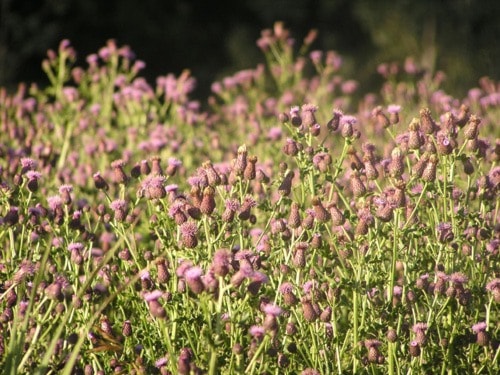Darrel Hill is the local contractor selected by the Northwest Invasive Plant Council of B.C. (NWIBC) to control or eradicate invasive weeds along the Hwy. 16 corridor from the Queen Charlotte Islands to Alberta. Invasive plants are described as non-native or non-indigenous species that adversely affect the habitats and bioregions they invade economically, environmentally, and/or ecologically. And everyone is familiar with some of the bad guys in our area; like orange hawkweed.
"The orange hawkweed in this area has gone so far past the point of being able to manage that we really don’t spend much time trying to control it unless it’s in a really sensitive area,” Hill explained.
It’s the same story with Canada thistle and bull thistle, Hill acknowledged, but there is a program available to assist private land owners with weed problems.
“If people in this area are interested, there is a program through the invasive plant council, a 50/50 program, where private land owners can apply for some help as far as the funding for getting their own land treated,” he said.
As the name suggests the NWIBC program will share the expense of land treatment with the land owner. The policy says ‘Landowners incurring a cost to control invasive weeds on their private land may be eligible for a 50 per cent reimbursement from the NWIBC. Rebates for chemical, mechanical and manual treatments will be considered to a maximum of $500.’ The landowner must hire a certified pesticide applicator with a valid service license, like Hill, to provide invasive plant treatment recommendations and a cost estimate.
Currently Hill spends most of his time targeting spotted knapweed, common tansy, and field scabious. “That’s a nasty one that we have a containment area for near Houston,” he said. “In a certain area in Buck Flats, field scabious has gotten so far out of control that it’s basically not manageable within our regular budget. So we draw a line around that area of land on a map and say we’ll spend our resources outside that area while continuing to monitor the contained patch.”
Field scabious also known as blue buttons or pincushion scabious, invades roadsides, pastures, and fields where it replaces desirable vegetation. The flowers of field scabious range from violet-blue to white in colour and are similar in shape to red clover flowers. All plant parts are covered in stiff hairs. Leaves are deeply divided and they decrease in size as you move toward the shoot.
“Most of these plants originate in Europe and Asia and come over as perennials that people like to grow in their gardens, and then they escape and get out of control because there are no natural predators or deterrents like birds and animals that feed on them,” said Hill.
And this results in a lot of hard work to control the weeds.
“More often than not for this program,” said Hill, “I do a lot of hands on work: pulling and digging and mowing. But there’s also some spraying. Mostly while treating the Hwy.16 right-of-way. I tend to use a selective herbicide that targets broad leaf weeds in particular because I don’t want to kill the grass,” he concluded.
For more information on the 50/50 program contact the Invasive Weed Council toll free at 1-866-WEEDS.
